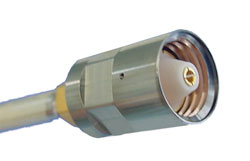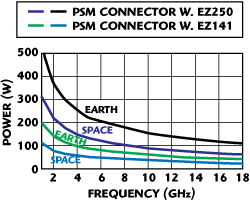
The well-known standard SMA connector is used worldwide in large quantities and in a variety of applications. For space applications, however, this type of connector is severely limited in its microwave CW power capability. This is because the SMA connectorís design is not optimized for corona, multi-paction and simple overheating effects. Hence, for any application with 10 W or more CW power, space grade TNC connectors have to be used that are much larger, heavier and, in many cases, oversized for the application.
ESA Initiative
Under the auspices of the European Space Agency (ESA), a European consortium comprising HUBER+SUHNER (Switzerland), LEMA/EPFL (Switzerland), TU Darmstadt (Germany) and ESTEC/ESA (Netherlands) was created and charged with the investigation and development of small-sized, high-power coaxial connectors. The project duration for the theoretical studies, design and manufacturing of prototype hardware and the power testing was two years.
From this research, HUBER+SUHNER has developed a space connector that has the dimensions of a standard SMA connector, but in terms of power capability comes close to the TNC connector. This new male connector is called Power Sub-Miniature (PSM) and is fully optimized with regard to RF-breakdown, corona, multi-paction and passive intermodulation effects as well as thermal power dissipation (patents are pending).

Figure 1 An SMA and a PSM chassis connector shown from above.

Figure 2 Connectors shown from the side mated with a 50 Ω termination (SMA) and a cable connector for the EZ141 cable (PSM).
Figure 1 shows a SMA and PSM chassis connector from above, while Figure 2 shows both connectors from the side mated with a 50 termination (SMA) and a cable connector (PSM). The chassis connectors shown in Figure 1 have the same ½ inch mechanical footprint. The interface dimensions, however, are different: the PSM has an inner conductor with a diameter of 1.7 and 5.5 mm for the dielectric, whereas the SMA has a 1.27 mm diameter inner conductor and the dielectric is 4.1 mm in diameter. Additionally, the PSM connector has no air gaps inside, preventing corona and multi-paction effects. The outside diameters of the SMA and PSM cable connectors or terminations shown in Figure 2 are the same.

High Power Testing
The test requirements for the PSM connector for L-, C- and Ku-band space applications are listed in Table 1. Roughly 80 percent of these requirements have already been tested successfully. The first PIM measurements showed less than -173 dBc for 2 × 40 W carrier powers at 1.8 GHz.
Corona, PIM and multi-paction are normally determined by the connector, whereas the power handling capability of a cable assembly can be limited either by the connector or by the coaxial cable. Figure 3 shows the maximum power that an EZ141 and EZ250 cable can handle in both space and Earth environments. The cables have a coating that has a radiation efficiency ε close to 1. The larger cable can handle more power than the smaller one; however, it is much heavier. Thus, the requirement is for an individually (weight) optimized cable assembly for any application.

Figure 3 Microwave CW power capability of a cable assembly with EZ141 and EZ250 coaxial cable in Earth and space environments (modelled).
Strategy
To address this requirement, HUBER+SUHNERís approach was to take a small, lightweight connector (PSM) with an interface designed for all required power levels and to have different cable entries for the different cables to be used. These cables are dependant on the power-frequency requirements; therefore, the optimum cable assembly is achieved for most applications. Of course, the useful cable limit is reached when the cable diameter becomes equal to the diameter of the connector and a ¼ inch cable like the EZ250 comes close to meeting these criteria. The result is one type of connector that, dependent on the power-frequency and weight requirements, can accommodate different cable types.

Figure 4 Distribution of the inner and outer cable temperature along a 1 m long cable assembly (modelled).
Thermal consideration
When two cables are connected to a housing or a chassis without a good heat path, the connector can cause severe problems if it is not properly coated. Figure 4 shows the distribution of the inner and outer conductor temperature along a 1 m long coaxial cable assembly. The upper set of curves describes a cable assembly with two shiny gold-coated PSM connectors with poor emissivity of only 2 percent, while the lower set of curves is for a cable assembly with connectors that have a special coating that has an emissivity of 100 percent. The emissivity of the cable (in Figure 4) is assumed to be 100 percent, although tests showed that a value of greater than 50 percent has been measured. Figure 4 also shows that connectors with poor emissivity can heat up more than the cable and limit the handling power of the cable assembly.
Conclusion and outlook
As multicarrier technology is increasingly being used in satellites, the necessity for cables and connectors in space-flight applications to meet demanding weight, power handling capabilities and exhibit low passive intermodulation is becoming a vital consideration. Therefore, the demand is for connectors to be optimized with regard to RF-breakdown, corona, multi-paction and passive intermodulation effects as well as thermal power dissipation. The first test results of HUBER+SUHNERís new power sub-miniature connector show that a small, lightweight connector for high power handling is achievable and work to develop the connector further is ongoing.
HUBER+SUHNER AG,
Herisau, Switzerland,
Tel: +41 71 353 41 11,
www.hubersuhner.com
